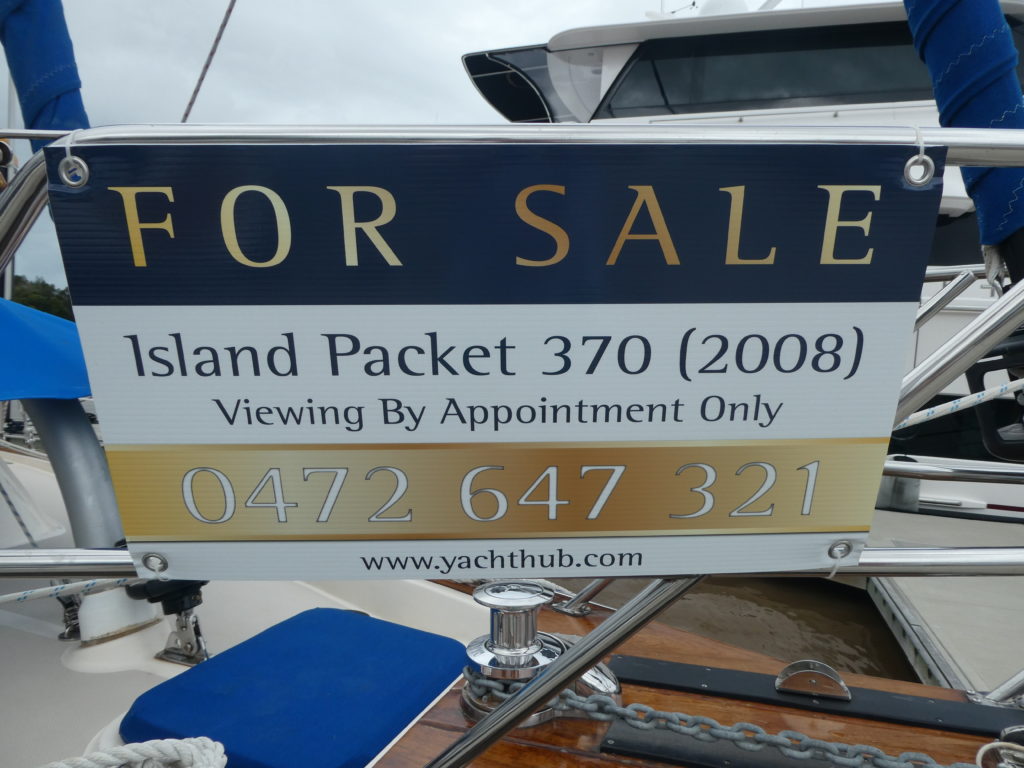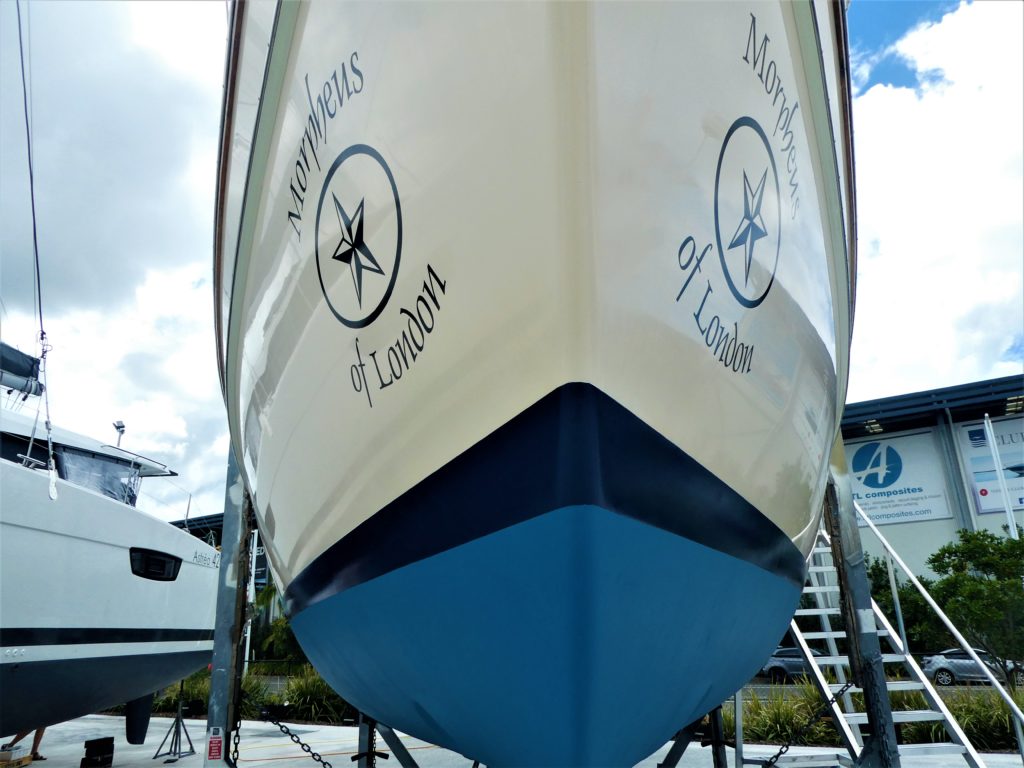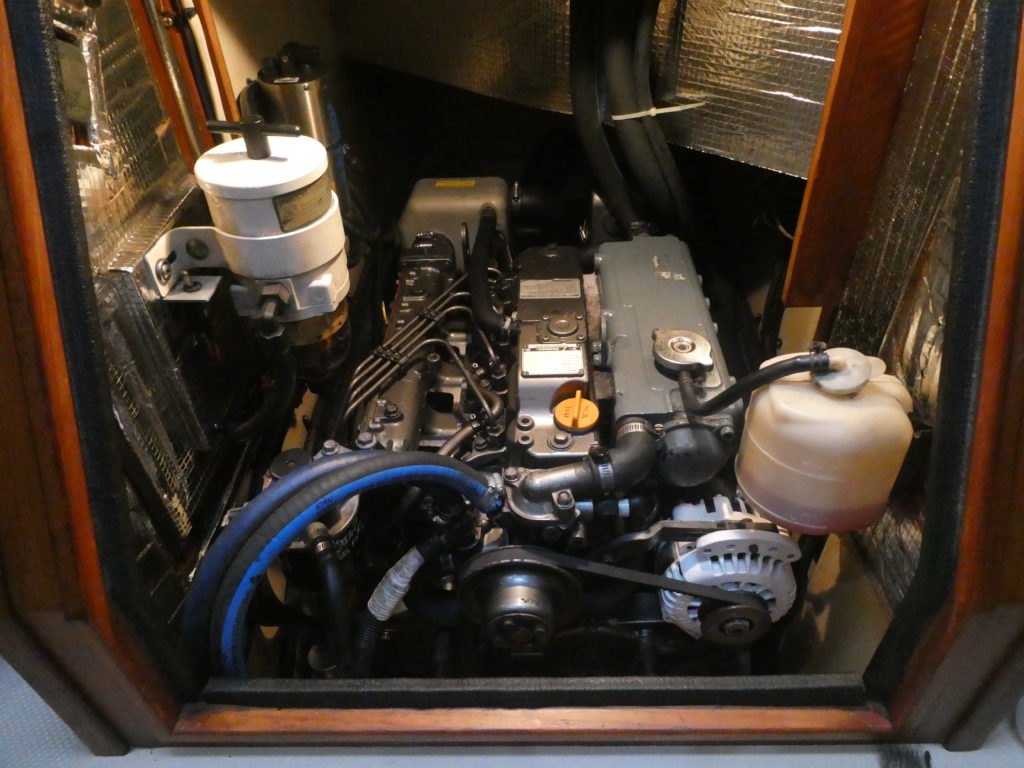So, you have made the decision to sell, how do you go about selling a private yacht in Australia? This blog reflects our experience of selling a foreign-flagged boat and is not meant to be a ‘how to do it’ just to give some insight into the process.
Importation valuation
A foreign-flagged vessel cannot legally be sold in Australia unless it has been imported first. This can be done by using a recent bill of sale but, for us, having purchased Morpheus in 2008 the original purchase price was too far removed in time to be of any use, especially as we had done so many upgrades for long-term cruising. So we employed a marine surveyor to value the boat for importation purposes. We had our in-water survey done in Bundaberg, Queensland, and it took about two weeks to get it organised.
Prior to the survey date we were requested to put together some notes to assist the process. We listed the age of Morpheus; age of the installed equipment such as sails; solar panels; electronics; engine age plus hours; water maker; batteries; outboard; dinghy; gas installation eg gas bottles / stove / BBQ; electrical installation eg 110V with step-down transformer to plug into 220V shore power; any maintenance requirements eg cutlass bearing / rudder bearing / stuffing gland / fibreglass waxing and polishing / interior and exterior varnish. We were quite detailed even down to the fact that the galley tap needed replacing….
You should not present the boat in tip top condition as the import valuation will be the starting point for the tax calculation so the lower the valuation the better. The cost of the survey was AUD $700 (November 2021).
We received the survey about three days later. The valuation was a bit higher than expected so we requested a breakdown but were told that this information was between the surveyor and customs only. So, basically, it is what it is! A bit frustrating but what can you do?!? Contact details: QLD Surveys Pty Ltd www.qldsurveys.com.au
Importation process
The next step is to get the duty / tax worked out. The official forms are not particularly straightforward so we decided to hire an importation broker to help us through the process. This broker was recommended by the cruising community and we dealt with her entirely via email and we found her very helpful, responsive and efficient. The cost was $600 which included all the official communication / documentation with the relevant authorities. Contact details: Bronwyn Revell, DMS Global Pty Limited bronwyn@dmsglobal.com.au
We supplied the following documents:
- Completed / signed Letter of Authority (to deal on our behalf)
- Photos of our passports
- British registry documentation for Morpheus
- In-date control (cruising) permit for Morpheus
- Wood pratique document (received on arrival into Australia, so don’t lose it!)
- Valuation survey and receipt
- Morpheus details – type / age / owners / builder / country of origin / HIN number.
- Dinghy – age / brand / model and value in Australian dollars
- Details about the outboard – age / brand / model and value in Australian dollars
Then there are some other details needed:
- Alcohol – how much did you have on board at the time of arrival into Australia. Yes, seriously! We just said that we did not recall but it was definitely within the duty-free limits in force at the time of arrival.
- Tobacco products – we had no products on board.
Itinerary
You need to put together an itinerary for the voyage to Australia, including dates, so, for example we listed (just the ports of entry / departure):
- Departed Bay of Islands, New Zealand, bound for Bundaberg, Australia, on 28 May 2019.
- Arrived Savusavu, Fiji, on 7 June 2019
- Departed Lautoka, Fiji, on 8 August 2019
- Arrived Port Vila, Vanuatu on 14 August 2019
- Departed Port Vila, Vanuatu on 27 September 2019
- Arrived Lifou, New Caledonia on 29 September 2019
- Departed Noumea, New Caledonia on 23 October 2019
- Arrived Bundaberg, Australia on 29 October 2019
So the last foreign port before Australia was Noumea, New Caledonia (6 day passage). So why is the last foreign port and passage period relevant? Well, the costs associated with getting to Australia are actually part of the taxable calculation.
Sailing costs (all in Australian dollars)
Essential costs: This is where you would itemise the cost of essential navigational items eg charts / tide tables / pilot books etc – but it is PRINTED documentation only. All electronic sources are not allowable.
Quarantine: We had no quarantine costs linked to ourselves or the boat on arrival into Australia.
Crew: This is where you list the crew wages / forage allowance and repatriation costs if applicable.
Victualling: We quoted victualling at $25 pp per day x 6 day passage.
Australian Customs entry fees: We entered Australia as part of the Down Under Rally which included all customs entry fees including the wood pratique, so recorded the rally fee of $495 for this element.
Medical supplies: We had a huge amount of medical supplies on board so simply looked up the cost of a Cat 1 Medical Kit for offshore sailing and recorded the purchase price.
Fuel supply: This was a difficult one! We topped up our diesel tank to full capacity at Total Cap Moselle (duty free) in New Caledonia post check-out. We managed to find transactions on our credit card statements so calculated the per litre cost and then calculated usage (and cost) on passage.
Official overseas cost: We included our marina fees at Port Moselle Harbour, Noumea plus the cost of the clearance and agent fees to depart.
Insurance: Both yacht insurance and personal travel insurance are based on annual policies – so we calculated daily rate multiplied by six day passage.
Spent in Australia on the boat since arrival: This is for new items only not regular maintenance elements. We included (supported by receipts) new solar panels; main sail worm drive bearings; gooseneck bearings; rigging inspection; new genoa tracks; new canvas; refurbishment of outboard; new coolant pump; gas bottle recertification; regalvanisation of anchor chain and new Rocna anchor
Duty / tax calculation
Follow this exact order to get to your calculation. If you supply the details Bronwyn will calculate it for you and let you know liability before proceeding:
- Valuation of boat less cost of valuation survey equals $?
- $? from 1 above less cost of additions added to boat in Australia equals $?
- $? from 2 above less quarantine costs equals $?
- $? from 3 above less Australian customs fees equals $?
- $? from 4 above less importation brokers fees equals $?
- $? from 5 above less 1/11 of this residual amount equals $?
- $? from 6 above less total of essential sailing costs (essential sailing costs + crew + victualling + medical + fuel + official overseas + insurance) equals $?
- $? from 7 above divided by 1.05 = $? CUSTOMS VALUE
So you pay the following: $? customs value + 5% duty (of customs value) + total of essential sailing costs = VOTI + 10% (of VOTI) = GST
So, as an example: $100,000 customs value + $5,000 duty + $1,500 total essential sailing costs = $106,500 VOTI 10% of VOTI = $10,650 GST.
So TOTAL PAYABLE (on a $100,00 customs value boat) = Duty $5,000 + $10,650 GST = $15,650
Please note: Australia and the USA have a trade agreement to import boats without duty however this is for new boats being shipped or sailed directly to Australia only. USA-manufactured boats who take their time crossing the Pacific are not exempt for import duty.
Selling privately
After importation (about a week or so after all documents have been submitted to the broker) you receive all the relevant customs documentation including a ‘permit to sell’. You will need this to list the boat. We decided to go it alone without a broker having been quoted 7.7% by a boat broker. As Island Packets are not particularly well known in Australia we didn’t think they would add any value to the process.
Important note – if you sell the boat within 90 days of the boat being imported – the customs can come back at you for the differential between the import valuation and the sales price you achieve. So you need to build this into your timelines to avoid any problems.
We then got busy doing all the improvements/maintenance in preparation for Morpheus being listed. In no particular order we varnished, waxed, polished, had new standing rigging installed, painted a new bootstripe, antifouled, serviced engine and sails etc etc. In our spare time we did lots of research into online advertising and decided upon BoatsonLine and YachtHub (which come together in a bundle for $34 for a year). We hired a storage unit nearby and cleared the boat of all our unnecessary clutter. We then cleaned cupboards, did some interior varnish work, cleaned upholstery, replaced taps, shower head, installed fresh water head for the toilet etc etc. Finally ready for viewing we took a selection of photos to go with our advert.
We drafted the advert, loaded up pictures then decided on the final value we would place on Morpheus. Quite difficult as Island Packets are not commonly available in Australia we checked out similar boats in the USA (although most were not to the same high specification as Morpheus) and then added the costs of importing the boat (ignoring the cost of actually getting the boat to Australia). Happy with our decision we published the advert and crossed everything flexible.

During our research we came across issues about gas and electrical installations. Electrics were fine as we had a ‘safety’ certificate and our leads were PAT tested despite not being Australian. As we were selling in Queensland the boat needed to have a gas certification (this is not the case in other Australian states). We were pretty irritated that we would have to strip out a really good quality fully-operational Force 10 cooker as part of the process as it didn’t have the right Australian label! If we didn’t sell Morpheus we would not be changing any of this so we made sure to add the clause to the advert that ‘Australian compliance would be at the purchaser’s cost’.
Within 24 hours we had a viewing….at this point we were on the hard without any rigging…but the couple were very keen. They turned up – hippy chick / influencer types – and clearly knew nothing about sailing. They gushed about Morpheus but we weren’t keen so didn’t contact them again. And, as expected, we didn’t hear from them again either.
Then we had another viewing and the guy said ‘don’t sell in the next 10 days, I want to bring my sons to check her out’. Very interested and quite hopeful. Oh yes and we had a couple of nutters who wanted to send us the money straight away if we shared our bank details….
It then went quiet and we heard nothing for a week or so…. The interested guy didn’t come back to us so we called him for feedback and he said that his wife had talked him out of it. So we finished our chores, got Morpheus all beautiful, and then decided to go out and about visiting friends.





After another week of radio silence we decided to drop the price and immediately got a flurry of new enquiries. By this time we had completed the boat refit, amended the advert to include new shiny photos, and based ourselves in Hope Island Marina for the viewings.

In the meantime we had received quite a few questions about how to safeguard the transaction for both the seller and the purchaser. We had contacted some lawyers about an escrow banking facility and the legal paperwork but they never got back to us – so we employed a boat broker just to do this element for us for a flat price (which equated to less than 1% of the sale price, as opposed to the 2.2% we had been quoted elsewhere). Really worth doing as he walked both us and the purchaser through the legal elements. We also, at this stage, updated the advert to reflect this facility. Highly recommend using this service. Contact details: Ian MacKenzie www.mackenzieboating.com.au sales@mackenzieboating.com.au
Finally we had a potential purchaser who wanted to make an offer and negotiate the price down by 10%. We explained our reasoning behind the price and the fact that we had already discounted the boat from original asking price so declined the offer. Think this was a bit of a shock to him but, eventually, he accepted our price as we explained that, if the survey found anything, we would negotiate from there.
We then did our paperwork with the broker who outlined the sales process. In Australia it follows the following format:
- Offer is accepted and deposit (usually 10%) is lodged with broker in escrow. Paperwork is drawn up. At this point we were blindsided as it is illegal to sell a boat without a gas certificate – we weren’t aware of that – we thought that this compliance element would be done in preparation for Queensland registration. As we had a full asking price offer we took the hit and managed to get it sorted out within a week.
- The purchasers come on board for a sea trial which we did the following weekend.
- Then the following week we hauled Morpheus out for a full structural survey (at the purchaser’s expense). The surveyor found nothing although he spotted the electrical sockets and the purchaser wanted to change it all to Australian standard. Fine we said – pointing out that we had paid for the gas install – and that the advert said it would be at the purchaser’s cost so he agreed to pick up that bill, we shook on it, and the deal was done.
- On a set date – about a week after the survey – the offer goes unconditional which means that the purchaser loses their deposit if they pull out. Then on a set date the deal is done, the money exchanges hands, and we left the boat.
In terms of our timings – we advertised originally 5 February and the money hit our account on 21 April – and we left Morpheus behind. We returned to the boat to do a final handover on the following Saturday and we were done! Time to learn to love being a land lubber again…. Hope you have found this latest blog useful and informative.
As an aside we are thoroughly enjoying our time at home so far seeing friends and family and, on a personal note, I’m having hip replacement surgery in August. So that’s it for now – once I’m back on my feet we’ll be planning our next adventures – so have a good summer everyone and watch this space!
Jan
